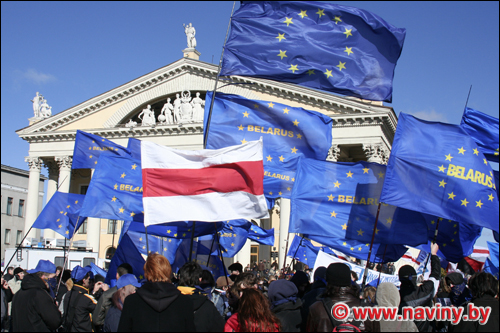
MARCHING TO EUROPE IN BELARUS
Publication: Eurasia Daily Monitor Volume: 4 Issue: 193
By:

On October 14, about 7,000 people took part in the European March for Freedom in Minsk. Participants demanded the fulfillment of 12 conditions set forth by the European Union as a precondition for the Belarusian government to become involved in the European Neighborhood Policy. Surprisingly, the Belarusian authorities, through the Minsk City Council, agreed to allow the demonstration. However, dozens of arrests and detentions of young activists took place beforehand, usually for such minor crimes as swearing in public. One detainee taped his mouth to avoid such a charge but was arrested anyway on the grounds that his vehicle was on a wanted list. In another case, an apartment was entered on the pretext that there was a dead body therein, but no such corpse was discovered (Kommersant, October 15).
The authorities also resorted to petty harassment, shutting down the websites of opposition political parties and groups prior to the march and quickly removing publicity posters about the event. Vintsuk Vyachorka of the Belarusian Popular Front reported that anonymous text messages were sent on behalf of chief organizer, Vikar Ivashkevich, to various residents of Minsk, inviting them to gather at an erroneous location. The City Council also prohibited the use of loudspeakers in the People’s Friendship Park near Bangalore Square, the designated site for the authorized gathering. Even the weather forecast on Belarusian Television issued a storm warning about ice and snow that proved to be fictitious (www.charter97.org, October 15).
Over 3,000 people, including a large contingent from the unregistered Young Front, gathered around 1:30 pm at Kastrychnitskaya (October) Square, the site of the mass protests that followed the presidential elections last year. Alyaksandr Milinkevich, one of the march leaders and the head of the Movement For Freedom, arrived at the square just after 2 pm and requested that participants walk to the Academy of Sciences, keeping strictly to the sidewalks and only crossing the main Nezalezhnasti (Independence) Avenue on a green “walk” light (www.charter97.org, October 15). However, given the number of protesters — carrying EU flags, the illegal Belarusian national white-red-white flags, and a blue banner with the slogan “Belarus to Europe” — it proved impossible for everyone to stay on the sidewalks.
Upon arrival at Peramoha (Victory) Square, demonstrators occupied all three lanes of the road. Vehicles from the State Auto Inspection Service (GAI) reportedly ran over people’s feet and nudged them with their car hoods to force them off the road. Other GAI troops left their vehicles and used their fists on protesters. At this point the march split into two groups: a group of about 5,000 led by Milinkevich and Anatol Lyabedzka of the United Civic Party that stopped at the Academy of Sciences, where several leaders gave speeches; and a second group of 1,500-2,000, composed mainly of young people, that remained on the road and set off for the National Library but evidently turned back upon reaching Cheluskintsev Park. Also, when the main group arrived at Bangalore Square, “several hundred” youths again broke away, walking on the road with a large European flag, 20 x 8 meters in size (Belapan, www.charter97.org, October 14).
In an interview, Charter 97 coordinator Zmiter Bandarenka revealed that riot police were operating in civilian clothing and provoked the disorderliness that resulted in the split into two columns. Some youths had eventually rejoined the main column. However, he also noted that he and others had advised some young radicals to hold their own protests rather than disrupt what was a law-abiding occasion (www.charter97.org, October 14).
The march elicited displays of support from neighboring capitals, including a small demonstration in Prague’s Vaclav Square, where the Belarusian national flag was unfurled as well as banners calling for Belarus to be admitted to Europe. About 100 Belarusian students currently enrolled at institutions in Warsaw through the Kastus Kalinouski program demonstrated in the city center along with Polish students. Support also came from the European parliament and from several Minsk-based diplomats of EU countries as well as the United States. European and U.S. media also reported the event in detail (Belorusskaya delovaya gazeta, October 15). In this respect, the European March was a success.
However, while government interference and provocations were in evidence, a distinction was also notable between those adhering to an orderly law-abiding march and others — mainly younger people — who defiantly occupied the main road. Belarusian Television reported negatively about “hooligans” who broke the law. Some protesters, such as Syarhey Kalyakin, leader of the currently unregistered Party of Communists, expressed disappointment at the relatively small size of the demonstration (Belapan, October 14). Several opposition leaders claimed that such occasions would continue until the Lukashenka “dictatorship” ends.
The Lukashenka regime gained some positive international publicity for permitting the March to go ahead, especially without the forbidding presence of OMON troops. Yet the opposition had no opportunity for a full-scale rally and it held the central square only briefly. The Lukashenka regime has yet to take any genuine steps either toward a dialogue with the opposition or to fulfilling any of the demands set forth by the EU. However, the president does not wish to close all doors to the West, particularly given his current disaffection with Moscow and what he terms the formation of a “cult of personality” around Russian President Vladimir Putin (AFP, October 13).




